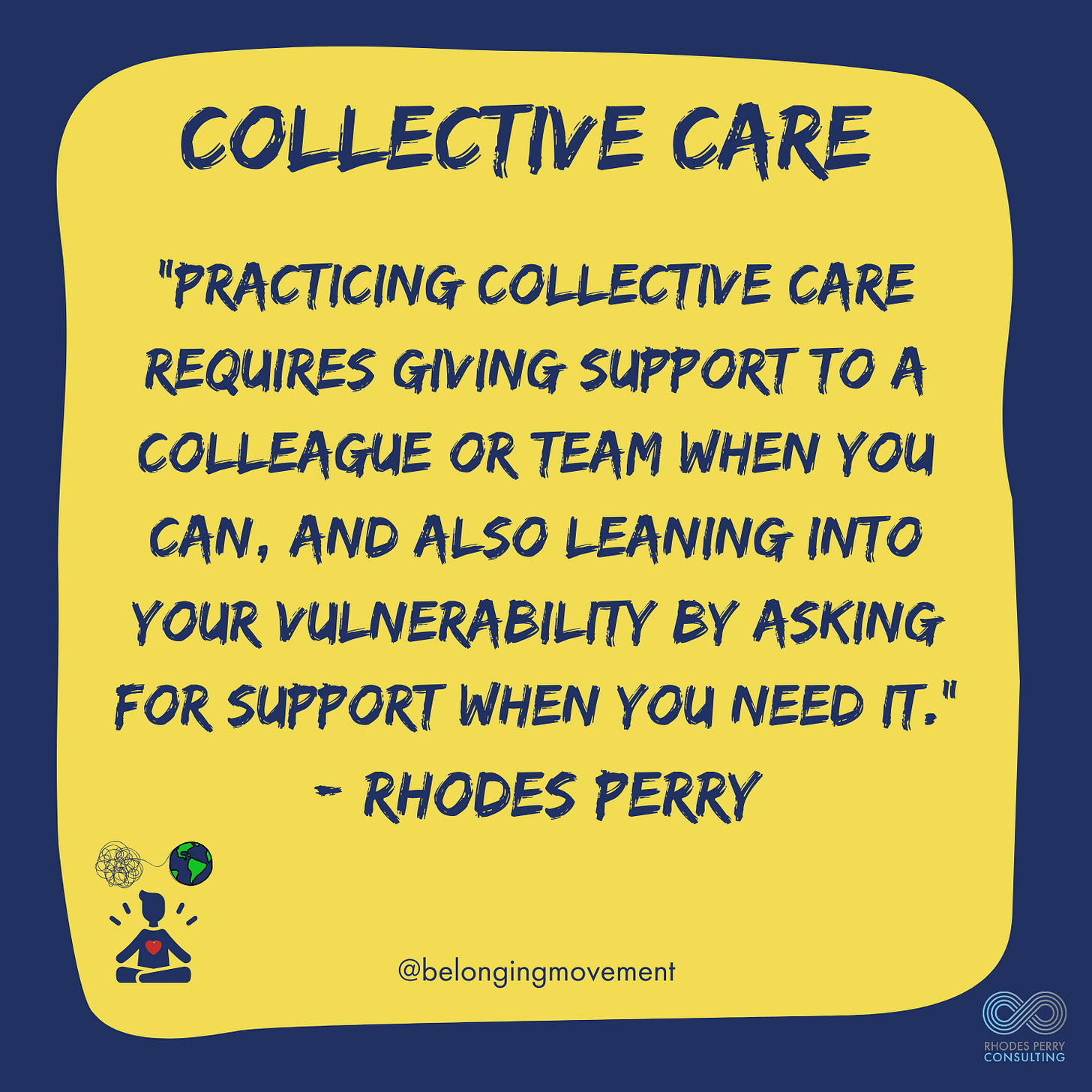Practicing Collective Care: A Response to Collective Trauma in the Workplace
The recent wave of anti-democratic actions in Washington, DC, is a stark example of collective trauma. Here's a collective care practice to help cope & acknowledge harm.
Last week, the U.S. Senate confirmed Russel Vought, a Project 2025 co-author, to lead the White House's Office of Management & Budget in a party-line vote.
Prior to his confirmation, Vought stated one of his primary goals as the Director of OMB is to “traumatize” and “villainize” the federal workforce.
Vought’s intentions are not merely an attack on the federal workforce; they are an assault on the very fabric of our society and a manifestation of collective trauma.
What is Collective Trauma?
Collective trauma refers to events that deeply impact an entire community or society, disrupting the trusting bonds that connect individuals.
Examples of collective trauma include natural disasters, social injustices, political upheavals, and systemic oppression.
The recent wave of anti-democratic actions in Washington, D.C., fueled by hate and division, is a stark example of collective trauma.
The end result? Many people, including those in your organization, and perhaps yourself, are feeling unsafe, anxious, isolated, and demoralized.
The Impact of Collective Trauma on Your Team
Collective trauma manifests in various ways in our society and certainly in the workplace. When it comes to your organization, here’s the troubling impact:
Decreased Engagement. Employees may experience anxiety, fear, and a sense of hopelessness, impacting their ability to focus and contribute effectively.
Erosion of Trust. A climate of fear and mistrust can undermine psychological safety, team cohesion, and open communication.
Increased Incivility. Employees may become more irritable, defensive, and prone to conflict as they grapple with emotional distress, increasing acts of incivility.
Burnout and Overwhelm. Constant exposure to negative news and the fear of further societal upheaval can significantly affect employee well-being.
The Power of Collective CARE
Responding to collective trauma requires a shift from individual-focused self-care activities into a more holistic approach that prioritizes team well-being or,
Collective Care
Practicing collective care requires giving support to a colleague or team when you can and also leaning into your vulnerability by asking for support when you need it.
Collective care also calls upon organizational leaders to address some of the systemic factors that contribute to trauma, and this is where the CARE Model can help.
[Image Description: A gold background with navy text that includes the collective care definition from above with an invitation to subscribe to the @belongingmovement YouTube Channel.]
The CARE Model: A Roadmap for Recovery
The CARE model, adopted from Judith Herman’s book Trauma and Recovery, offers a valuable framework for organizations to respond to collective trauma.
It includes four CARE actions:
Cope. When collective trauma occurs, it’s important to provide immediate support to employees, ensure their safety, and address their immediate needs.
Acknowledge. Name the collective trauma impacting the workforce and create belonging spaces to acknowledge the emotional toll on staff.
Remember. Share stories of what has happened at both the individual and organizational levels, including the impact of trauma, loss, and grief.
Emerge. Develop long-term strategies for effectively responding to future collective trauma to create the space for healing and resilience to emerge.
Practicing Collective CARE
Currently, employees are left figuring out how to recover from the harm of the collective traumatization we are all enduring with very little organizational support.
Understandably, organizational leaders are busy navigating the material impact of this collective trauma, and many lack trauma-informed skills to create the space to repair.
To develop the type of leaders capable of practicing collective CARE and repairing workforce trauma, organizations must:
Educate Leaders. Equip leaders at all levels with the awareness and proven skills to effectively respond to collective trauma.
Address Barriers. Ensure that employees have access to mental health resources, flexible work arrangements, wellness programs, and other support services.
Create a CARE Team. Establish a cross-functional team to implement the collective CARE model and coordinate employee well-being support efforts.
Assess Recovery. Continuously assess the organization's current phase in the repair process and adjust collective CARE interventions accordingly.
Implement Interventions. Develop and implement a range of trauma-informed healing modalities, like those offered through The Belonging Practice.
Test and Change. The effectiveness of the Collective CARE practice should be regularly reviewed and evaluated, and adjustments should be made as needed.
Need Support? RPC Can Help!
Collective trauma presents a significant challenge to organizations, and practicing Collective CARE can help.
At Rhodes Perry Consulting, we developed our Collective CARE Practice Guide and a suite of somatic coaching and training programs to help.
One coping & acknowledgement practice you can do right now is to experience this grounding body scan practice.
[Image Description: A navy background with gold text that reads, “Join the Belonging Practice, Thursdays at 8 am PT with a YouTube video player featuring an image of Rhodes Perry, wearing clear glasses, a gray hat, a green sweater in his office, leading a centering practice and an invite to subscribe to his newsletter.]
If you’d like to explore how my company’s Collective CARE Practice can support you and your team, please contact us here.
Join our next Belonging Practice this Thursday if you’d like to experience the Collective CARE Practice in a supportive community of visionaries.
[Image Description: A navy background with gold text that reads, "Practice Belonging," with an image of a person meditating with a red heart on their chest, a jumble of chaos above their left shoulder, and an image of planet Earth on the right.]
Practicing Collective CARE is the medicine your organization needs to support your staff and lead through these enormously challenging times.
Together, let’s strengthen our Belonging Movement by practicing Collective CARE.






